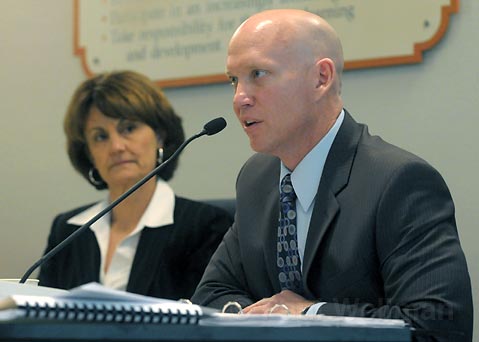School Board Begins Budget Blood Bath
Grim Options Considered for $3 Million in Necessary Cuts

In what is becoming an unfortunately annual April occurrence, the Santa Barbara School Board once again began the painful process of general-fund budget cuts this week. And while a final vote on what exactly will bleed away when the budgetary blade comes down later this month is still a few weeks away, the outlook isn’t too pretty, according to Eric Smith, the district’s deputy superintendent and financial guru. For the fourth time since 2004, the Santa Barbara School District will have to make millions of dollars in budget cuts in order to remain fiscally afloat-a process that assuredly means the end of programs and the loss of teaching positions. All told, even if the education measures in next month’s special elections pass, the district, as Smith told board members Tuesday night, is looking at a minimum of $3 million in reductions.
Though the board won’t officially identify programs, practices, and positions destined for the scrap heap until its April 28 meeting, Smith gave trustees a menu of sorts this week from which they will be making their gut-wrenching selections later in the month. After spending much of the past few months visiting the campus of every school in both the elementary and high school districts and meeting with teachers, administrators, and staff, Smith identified 33 specific areas that could be cut or, at best, manipulated in the name of cash, and an additional 20 other options of varying-though less immediate-intrigue.
Ranging from things like disconnecting unnecessary phone lines at schools and beefing up on-site recycling efforts in order to qualify for lucrative Santa Barbara City incentives to getting rid of school counselors and stopping freshman athletics at all three high schools, the list of possible cuts covered everything from no-brainer simple housekeeping maneuvers to outright controversial propositions. And, after enduring just over $4 million in cuts last year and $2.5 million the year before, some items found their way onto the list out of sheer creativity-such as making all certificated administrators work as substitute teachers three days a year or charging students for bus services to and from school-or out of pure desperation. Two recommendations fall into the latter category: maneuvers that have been discussed in the past but shelved because prior boards have been unwilling to go there. One is to staff all high schools at parity levels-something that would result in many teacher terminations at San Marcos High School due to its unique block scheduling format. And the other is the elimination of 9th grade English class-size reductions. If carried out, those two cuts alone would save the district roughly $900,000. “It’s sad we must make budget cuts again this year, but it’s a reality : We have to do it,” explained a visibly weary Superintendent Brian Sarvis Tuesday night.
Other possible cuts and policy changes include increasing the kindergarten3rd grade class-size averages, making students attend Saturday school for truancy, doing away with athletic trainers, reduction of assistant principal assignments at junior high schools, charging for parking at school sports events, more frugal electricity management at school sites, and increasing the rental rates on things like school pools, auditoriums, and athletic fields. On the subject of electrical efficiency, preliminary calculations indicate that shutting off unused computers alone could save the district $75,000.
For their part, boardmembers all expressed a desire to “make the cuts as far away from the students, teachers, and classrooms as possible,” as Santa Barbara Teachers Association president Lane Wheeler urged them to do during public comment. However, after listening to the trustees opine as to which parts of Smith’s menu gave them pause and which parts they could live with, it was clear to the capacity crowd in attendance that no one would be saved from the pain. A preliminary survey of the five-member board found the majority reluctantly in favor of staffing the high schools at parity, hesitant to cut school counselor jobs, committed to protecting freshman athletics, undecided about athletic trainer positions, regretfully realistic about having to increase class sizes, and all but certain that parents wouldn’t be willing to pony up cash to bus their kids to school. In short, as boardmember Bob No»l put it, “We are all going to have to share the suffering.”



